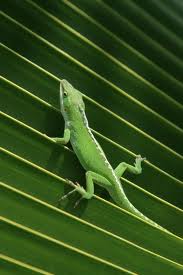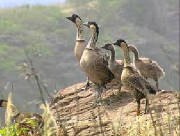|
The Nene, also known as Nene and Hawaiian Goose, (Branta sandvicensis)
is a species of goose endemic to the Hawaiian Islands. The official bird of the state of Hawai'i, the Nene is exclusively
found in the wild on the islands of Maui, Kaua'i and Hawai'i. The Hawaiian name Nene comes from its soft call.
The Nene evolved from the Canada Goose (Branta canadensis), which most likely migrated to the Hawaiian
islands 500,000 years ago, shortly after the island of Hawai'i was formed. This ancestor is the progenitor of the Nene as
well as the prehistoric Giant Hawai'i Goose[3] and Nene-nui (Branta hylobadistes). The Nene-nui was larger than the Nene,
varied from flightless to flighted depending on the individual, and inhabited the island of Maui. Similar fossil geese found
on O'ahu and Kaua'i may be of the same species. The Giant Hawai'i Goose was restricted to the island of Hawai'i and measured
1.2 metres (3.9 ft) in length with a mass of 8.6 kilograms (19 lb), making it more than four times larger than the Nene. It
is believed that the herbivorous Giant Hawai'i Goose occupied the same ecological niche as the goose-like ducks known as moa-nalo,
which were not present on the Big Island.[4] Based on mitochondrial DNA found in fossils, all Hawaiian geese, living and dead,
are closely related to the Giant Canada Goose (B. c. maxima) and Dusky Canada Goose (B. c. occidentalis)
Mo’o are the powerful lizard (or dragon) water spirits of Hawai’i.
Mo’o inhabit waterfalls, fishponds, even the ocean. In the words of Lilikala Kame'eleihiwa, Ph.D., Director, Center
for Hawaiian Studies, University of Hawai'i at Manoa:“Mo’o were greatly feared and revered throughout Polynesia;
in Hawai’i they are almost always female.”1 As with most Hawaiian akua (gods), mo’o could appear in various
forms, in this case, they were usually either reptilian or human. Some sources say Mo’oinanea is the “matriarch”
of mo’o gods and goddesses, including Haumea, Kihanuilulumoku, Waka and others. 2 Others give Haumea the matriarchial
credit for both mo’o and human lineage: “She lives today in every Hawaiian woman...I too am Haumea and all that
Haumea has done, I can do as well.
|

